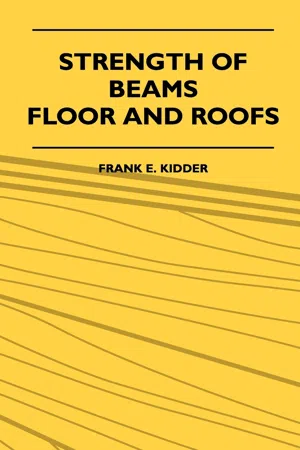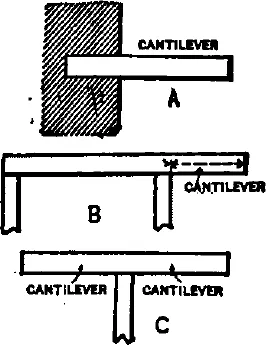
eBook - ePub
Strength Of Beams, Floor And Roofs - Including Directions For Designing And Detailing Roof Trusses, With Criticism Of Various Forms Of Timber Construction
This is a test
- 232 pages
- English
- ePUB (mobile friendly)
- Available on iOS & Android
eBook - ePub
Strength Of Beams, Floor And Roofs - Including Directions For Designing And Detailing Roof Trusses, With Criticism Of Various Forms Of Timber Construction
Book details
Book preview
Table of contents
Citations
About This Book
Many of the earliest books, particularly those dating back to the 1900s and before, are now extremely scarce and increasingly expensive. We are republishing these classic works in affordable, high quality, modern editions, using the original text and artwork.
Frequently asked questions
At the moment all of our mobile-responsive ePub books are available to download via the app. Most of our PDFs are also available to download and we're working on making the final remaining ones downloadable now. Learn more here.
Both plans give you full access to the library and all of Perlego’s features. The only differences are the price and subscription period: With the annual plan you’ll save around 30% compared to 12 months on the monthly plan.
We are an online textbook subscription service, where you can get access to an entire online library for less than the price of a single book per month. With over 1 million books across 1000+ topics, we’ve got you covered! Learn more here.
Look out for the read-aloud symbol on your next book to see if you can listen to it. The read-aloud tool reads text aloud for you, highlighting the text as it is being read. You can pause it, speed it up and slow it down. Learn more here.
Yes, you can access Strength Of Beams, Floor And Roofs - Including Directions For Designing And Detailing Roof Trusses, With Criticism Of Various Forms Of Timber Construction by Frank E. Kidder in PDF and/or ePUB format, as well as other popular books in Technology & Engineering & Engineering General. We have over one million books available in our catalogue for you to explore.
Information
CHAPTER I.
DETERMINING THE STRENGTH OF WOODEN BEAMS.
Many persons doubtless think that the strength of wooden beams is a matter of conjecture and not of mathematics, but except for a slight variation in the strength of the wood, due to different conditions inherent in the tree and also in the degree of seasoning, the strength of a given beam can be very accurately determined by simple calculations. Even with the variation due to the wood, it is possible to determine the maximum load that it is safe to put upon a beam, which is usually the information desired.

Fig. 1.—Showing Meaning of Terms Used.

Fig. 2.—Some Forms of Cantilever Beam.
Before giving any rules, however, it will be well to consider some of the facts relating to the strength of beams. The strength of a beam depends upon its size and shape, its span, (or if a cantilever, the projection beyond the point of support), the kind of wood and its condition, and also the manner of loading. The following facts are also true of all rectangular wooden beams:
1. The strength of a beam decreases in the proportion that its span is increased. Thus the strength of a given beam, with a span of 10 feet, is one-half that of the same beam with a 5-foot span. With a span of 12 feet the strength will be five-sixths what it would be with a span of 10 feet. Or if we have a beam with a span of 20 feet and place a support under the center we just double the strength.
2. The strength of a beam increases exactly as its breadth or thickness is increased. Thus a beam 2 inches thick is twice as strong as a beam 1 inch thick, provided the other conditions remain the same.
3. The strength of a beam increases in proportion to the square of its depth. A 2 × 8 inch beam will be four times as strong as a 2 × 4 inch beam, and a 2 × 12 inch beam will be nine times as strong as a 2 × 4 inch beam, the square of four being 16, and of twelve 144, or nine times as great.
It follows from the second and third paragraphs that the strength of a rectangular beam is in proportion to the product of the breadth by the square of the depth if the span remains the same. A knowledge of these facts is very important for the wise use of timber.
A beam 8 × 8 contains 64 square inches in cross section, and a beam 6 × 10 contains 60 square inches, yet their strength will be in the proportion of 512 (8 × 8 × 8) to 600 (6 × 10 × 10), the 6 × 10 beam being the stronger. The strength of a 6 × 8 inch beam on edge in proportion to the strength of the same beam laid flat wise is as 6 × 8 × 8 to 8 × 6 × 6, or 384 to 288.
Deep beams are also very much stiffer than shallow beams, the resistance of a beam to bending increasing in proportion to the cube of the depth. The stiffness therefore of a 2 × 12 inch beam and a 2 × 10 inch beam is in the proportion of the cube of 12 to the cube of 10, or 1728 to 1000. This property of stiffness is very important in floor joists, where the span in feet is usually greater than the depth in inches, but for shorter beams it need not be considered.
In speaking of the strength or stiffness of beams the breadth of the beam always refers to the thickness measured horizontally, and the depth to the height of the beam as it sets in place, without regard to which is the larger dimension. When a beam is supported at each end the distance between supports is called the span. The distance which the ends rest on their support is called the bearing.
MEASURE OF BREADTH, DEPTH AND SPAN.
In the rules hereinafter given the breadth and depth of the beam are always supposed to be measured in inches and the span in feet. The meaning of the terms referred to is clearly shown in Fig. 1. Beams are also sometimes supported at three or more points, in which case they are called continuous beams. These will be considered in their proper place. There is also the cantilever beam, or a beam fixed at one end. The cantilever portion of the beam is that which projects beyond the support. The other end may be fixed in a wall, as at A, Fig. 2, or it may be held down by its own weight and the load on it, as at B. A beam supported at the center only, as at C, is a double cantilever, each side being considered as a cantilever. All three cases are met with in building construction, although that shown at B is the most common.
There are also different ways of loading a beam, although loads are usually classed either as distributed or concentrated. A distributed load is one that is applied over the entire length of the span, and when the load is uniform, as in the case of a plain brick wall of uniform height, the load is called uniformly distributed. Floor loads, although as a matter of fact not absolutely uniform, are generally considered as such. Floor joists resting on a girder may be considered as a uniformly distributed load, when the joists are not spaced more than 2 feet on centers. When they are spaced 4 feet or more on centers they should be considered as a series of concentrated loads.
A concentrated load is one that is applied at a single point of a beam, although in practice the “point” may be perhaps 3 feet long. An iron safe resting on the center of a beam 10 feet or more in length would be considered as a concentrated load. The end of a header framed to a trimmer is also a concentrated load, as is also a partition extending across a series of beams or joists.
The effect of a concentrated load applied at the center of a beam is just twice as great as if the load were uniformly distributed. When the load is applied between the center and the end the effect may be greater or less than that of a distributed load, according as the point of application is nearer to the center or to the support.
LIVE AND DEAD LOADS.
Loads are also spoken of as “live” and “dead” loads. A dead load is one that does not move of itself, such as the weight of any kind of material or a brick wall, for instance. A live load is one that is constantly moving and quickly applied. Live loads that produce a decided impact or vibrations are nearly twice as destructive as those that remain perfectly still. The principal live loads met with in building construction are moving crowds of people, particularly if they move in regular time, as in dancing or marching; machinery and wind pressure.
RULES FOR THE STRENGTH OF BEAMS.
The strength of a beam subject to almost any of the different variations of loading may be determined with about the same degree of accuracy as if simply loaded at the center, but the calculations require a considerable knowledge of mathematics, so that only a few of the more common cases can be covered by simple rules. These we will now consider.
When considering the strength of beams we usually have either one of two problems to solve—namely, to find the strength of a given beam or to determine the necessary size of beam to support a given load. The same algebraic formula really answers for both, but fo...
Table of contents
- Cover
- Title
- Table of Contents
- List of Tables
- Preface
- Chapter I. Determining the Strength of Wooden Beams
- Chapter II. How to Determine the Strength or Safe Load of Wooden Floors
- Chapter III. How to Compute the Size of Floor Timbers for New Buildings
- Chapter IV. Types of Wooden Roof Trusses—showing number and correct position of members and the action of the stresses.—Triangular and Queen Trusses.—Trusses for Flat Roofs.—Scissors Trusses
- Chapter V. Determining the Stresses in Roof Trusses
- Chapter VI. How to Compute the Size of Truss Members
- Chapter VII. Proportioning the Joints of Wooden Roof Trusses
- Chapter VIII. Wind Bracing of Buildings, Towers and Spires
- Chapter IX. Examples of Truss Construction, with Criticisms by the Author
- Index